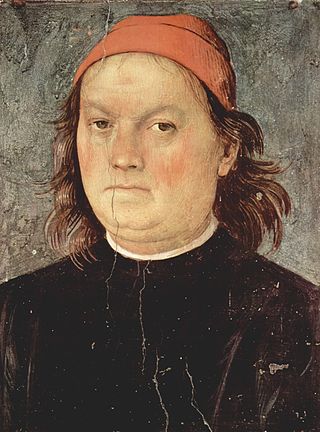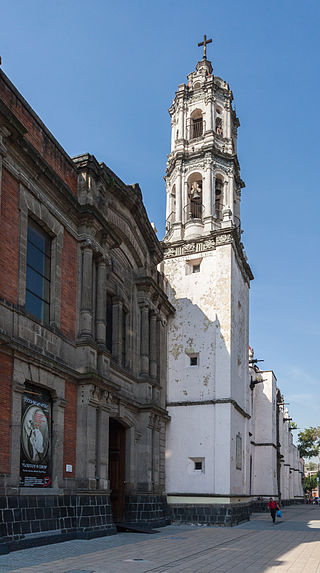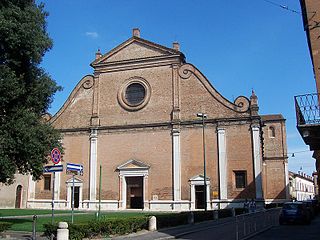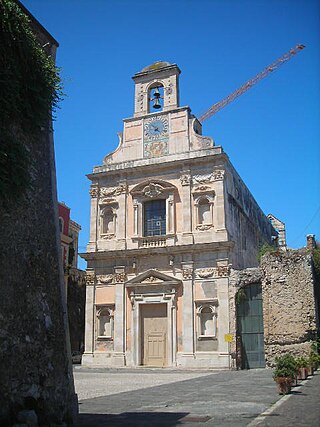
Sant'Agostino is a Baroque-style Roman Catholic church located on Via Scevola Riceputi #1, in Cesena, region of Emilia-Romagna, Italy.

Sant'Agostino is a Baroque-style Roman Catholic church located on Via Scevola Riceputi #1, in Cesena, region of Emilia-Romagna, Italy.
A church and convent at the site was erected in 1252, which was manned by the Franciscan Friars (Padri Riformati dell'Osservanza). Violante da Montefeltro, wife of Malatesta Novello, commissioned a reconstruction of the church, transferring in 1457 the monks to a convent adjacent to the Chiesa dell'Osservanza in Cesena. Augustinians from the Hermitage of San Giovan Buono, which was located outside Cesena, were then brought here. From 1748 to 1777, commissioning designs by Luigi Vanvitelli, the Augustinians replaced the earlier structure with the present church and convent. The main altarpiece originally was a Virgin in Glory with God the Father, and venerated by the Fathers of the Church by Girolamo Genga; the painting was appropriated by the Napoleonic authorities and transported to the Pinacoteca di Brera. The bell tower was designed by Pietro Carlo Borboni. The main portal by Sebastiano Bernava.

Among the internal decoration now in the church. The paintings for the 1st and 2nd altars on right are by Aureliano Milani. The 3rd altar has an early 14th-century Crucifixion scene with polychrome wood statues of the Virgin, John the Baptist. A canvas of the Massacred of the Innocents (1640) was painted by Giovanni Battista Razzani. The canvas depicting the Immaculate Conception and Saints James and Erasmus of Capua (1670) was painted by Cristoforo Serra. The gilded stucco altarpiece was completed by Marcantonio Fava. It was part of a polyptych whose main wooden panel is the Disputation of the Immaculate conception now housed in Brera. The upper sections of the apse now have a copy of Genga's Annunciation (circa 1500), while the original is in the Cesena Cathedral museum. [1] There is also a painting by Bartolomeo Coda. [2]

Pietro Perugino, an Italian Renaissance painter of the Umbrian school, developed some of the qualities that found classic expression in the High Renaissance. Raphael became his most famous pupil.

The Virgin of the Rocks, sometimes the Madonna of the Rocks, is the name of two paintings by the Italian Renaissance artist Leonardo da Vinci, of the same subject, with a composition which is identical except for several significant details. The version generally considered the prime version, the earlier of the two, is unrestored and hangs in the Louvre in Paris. The other, which was restored between 2008 and 2010, hangs in the National Gallery, London. The works are often known as the Louvre Virgin of the Rocks and London Virgin of the Rocks respectively. The paintings are both nearly 2 metres high and are painted in oils. Both were originally painted on wooden panels, but the Louvre version has been transferred to canvas.

San Gaetano, also known as Santi Michele e Gaetano, is a Baroque church in Florence, Italy, located on the Piazza Antinori, entrusted to the Institute of Christ the King Sovereign Priest.

The Basilica dell'Osservanza is a church on the outskirts of Siena, region of Tuscany, Italy.

San Bernardino is a church in Verona, northern Italy. The church, in Gothic style, was built from 1451 to 1466.

Jacopo Zoboli was an Italian painter.

Regina Coeli Convent Church is a Roman Catholic parish church and former convent built in the historic center of Mexico City, on the corner of Regina and Bolivar Streets.

Volterra Cathedral is a Roman Catholic cathedral in Volterra, Italy, dedicated to the Assumption of the Virgin Mary. It is the seat of the bishop of Volterra.

The Cybo or Saint Lawrence Chapel is the second side chapel in the right-hand aisle of the Basilica of Santa Maria del Popolo in Rome. For the beauty of its paintings, the preciousness of marble revetments covering its walls and the importance of the artists involved in its construction the chapel is regarded one of the most significant sacral monuments erected in Rome in the last quarter of the 17th century.
Michelangelo Spada was an Italian painter in Verona. He should not be confused with the 16th century Count Michelangelo Spada of Terni who was chamberlain of Pope Julius III.

San Filippo Neri is a late-Baroque style, Roman Catholic church located in Turin, region of Piedmont, Italy. The church is located on Via Maria Vittoria 5; the left flank of the nave faces the Turin Academy of Sciences. The church is still used for services. 69 metres (226 ft) long and 37 metres (121 ft) wide, it is the largest church in the city of Turin.

San Francesco is a late-Renaissance, Roman Catholic minor basilica church located on via Terranuova in Ferrara, Emilia-Romagna, Italy.

The Sanctuary of the Santissima Annunziata is a Baroque Roman Catholic church in Gaeta, region of Lazio, Italy.

San Francesco is a Roman Catholic church located on Via Emilia in the town of Castelbolognese, in the region of Emilia Romagna, Italy.

Santa Maria Egiziaca a Pizzofalcone is a Baroque-style, Roman Catholic, Basilica church on the street of the titular name in the hill of Pizzofalcone, in the historic center of Naples, region of Campania, Italy. The church layout was initially designed by Cosimo Fanzago.

Sarsina Cathedral is a Roman Catholic cathedral in Sarsina, a municipality in the province of Forlì-Cesena, region of Emilia-Romagna, Italy, dedicated to the Annunciation of the Virgin Mary. Formerly the seat of the Bishops of Sarsina, since 1986 it has been a co-cathedral of the Diocese of Cesena-Sarsina.

Cagli Cathedral is a Roman Catholic cathedral in the town of Cagli, in the province of Pesaro and Urbino, region of Marche, Italy, dedicated to the Assumption of the Virgin Mary. It was formerly the episcopal seat of the Diocese of Cagli; since 1986 it has been a co-cathedral in the Diocese of Fano-Fossombrone-Cagli-Pergola. It was granted the status of a minor basilica in 1982.
Paolo Gamba was an Italian painter of the late Baroque period, active in the region of Molise.

The Church of St George and the Immaculate Conception is the Roman Catholic parish church of Carimate, province of Como, Lombardy, northern Italy.

San Barnaba is a deconsecrated Baroque-style, Roman Catholic church, located on Corso Magenta #44, near Piazzale Arnaldo, in Brescia, region of Lombardy, Italy. The church in the 20th century became an auditorium and conference hall, and home of the Conservatorio Luca Marenzio.